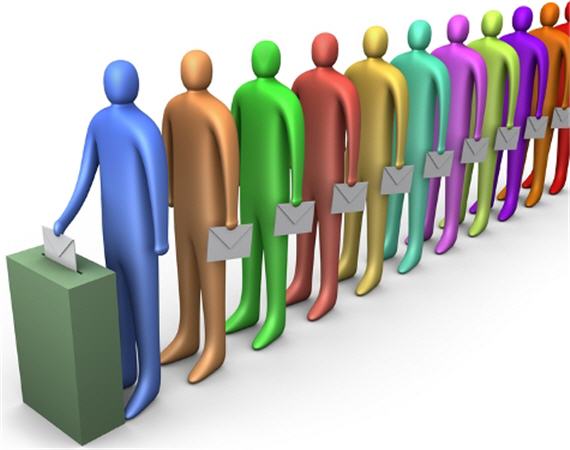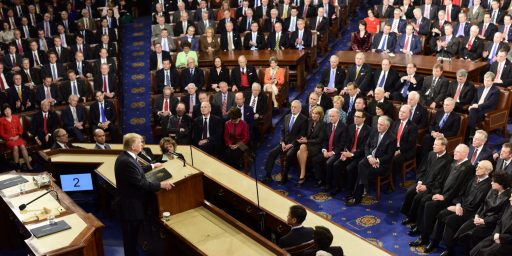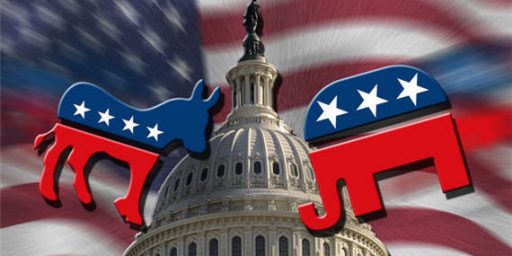Challenges to the Health of American Democracy
Democratic norms are eroding.
Political Scientists Steven Levitsky and Daniel Ziblatt have a column in the NYT that is worth a read: How Wobbly Is Our Democracy? While the piece starts off with the president, he isn’t the main focus, but rather it raises a number of very salient issues about the health of our democratic norms.
Along those lines, they introduce the concepts of mutual toleration and forbearance:
To function well, democratic constitutions must be reinforced by two basic norms, or unwritten rules. The first is mutual toleration, according to which politicians accept their opponents as legitimate. When mutual toleration exists, we recognize that our partisan rivals are loyal citizens who love our country just as we do.
The second norm is forbearance, or self-restraint in the exercise of power. Forbearance is the act of not exercising a legal right. In politics, it means not deploying one’s institutional prerogatives to the hilt, even if it’s legal to do so.
I would note that there has been a clear and growing lack of mutual toleration. I immediately think of Sarah Palin’s “real America” comment or Michele Bachmann talking about “pro-America” or “anti-America” members of Congress.
They then note a growing evolution of our parties and their polarized nature:
America today is not on the brink of a coup or a civil war. Yet our parties are more polarized than at any time during the last century. Whereas 50 years ago some 5 percent of either Democrats or Republicans said they would be displeased if their child married someone from the other party, today 49 percent of Republicans and 33 percent of Democrats say so. According to a recent Pew Research Center survey, 49 percent of Republicans and 55 percent of Democrats say the other party makes them “afraid.”
This is not a traditional liberal-conservative divide. People don’t fear and loathe one another over taxes or health care. As political scientists have shown, the roots of today’s polarization are racial and cultural. Whereas 50 years ago both parties were overwhelmingly white and equally religious, advances in civil rights, decades of immigration and the migration of religious conservatives to the Republican Party have given rise to two fundamentally different parties: one that is ethnically diverse and increasingly secular and one that is overwhelmingly white and predominantly Christian.
White Christians are not just any group: They are a once-dominant majority in decline. When a dominant group’s social status is threatened, racial and cultural differences can be perceived as existential and irreconcilable. The resulting polarization preceded (indeed, made possible) the Trump presidency, and it is likely to persist after it.
Emphasis mine. The core identity issues here are not to be ignored, nor is the concern over the decline in relative power of white Christians. Evangelicals have long been taught that they are persecuted by this world, and loss of influence is seen as confirmation of this lesson. We are certainly seeing the degree to which some evangelical leaders are willing to go to remarkable lengths to maintain their affiliation with the power of the majority party and its leader, Donald Trump. The identity issues are quite clear in the various iterations of the immigration debate, and the whole notion of making America “great again.”
They go on to note, in regards to mutual toleration:
Extreme partisan polarization had already begun to eviscerate our democratic norms long before Mr. Trump’s election. By the time of Barack Obama’s presidency, many Republicans had abandoned mutual toleration. Prominent Republicans attacked Mr. Obama and the Democrats as anti-American. And of course, in 2016, the Republican Party nominated for president a man who questioned Mr. Obama’s citizenship and insisted that his rival was a criminal.
In regards to forbearance:
Polarization also encouraged politicians to abandon forbearance, beginning with the Gingrich-era government shutdowns and the partisan impeachment of Bill Clinton. Other examples include proliferating filibuster use, congressional refusal to raise the debt limit and President Obama’s use of executive actions to bypass Congress.
Perhaps the most consequential was the Senate’s refusal to take up Mr. Obama’s nomination of Merrick Garland to the Supreme Court.
[…]
Democrats are beginning to respond in kind. Their recent filibuster triggering a government shutdown took a page out of the Gingrich playbook. And if they retake the Senate in 2018, there is talk of denying President Trump the opportunity to fill any Supreme Court vacancy. This is a dangerous spiral.
I would note our system is designed with numerous veto points (legislation can be stopped in the House, in the Senate, and on the desk of the President). Polarized parties that cannot negotiate with each other ensure an impasse. It is one of the reasons we find ourselves without a formal budget for so long.







Interesting, and thank you for posting this. But it does seem to be a little odd, and a little late, for handwringing over the eroding of norms from the newspaper that has spent 20 years going after the Clintons (and 600 consecutive days on HRC’s emails). The NYT, in particular, has been a big enabler of normalizing Republican antics, right wing idiocy, and 45*. This weekend alone saw an article justifying Stephen Miller’s “usefulness” on Holocaust Remembrance Day and a lovely little clickbait headline about Cecile Richards: “National hero or deeply evil woman?” If the NYT wants to be taken seriously, perhaps they should be reporting seriously – every day, perhaps for 600 consecutive days – about the erosion of these norms they claim to hold so dear.
At least as important as the two issues pointed out is the lack of a consensus even on basic issues. Polls have found that many Americans can’t name any rights secured by the First Amendment or even recognize it when it’s shown to them or even agree with it. And the number disagreeing with it is increasing.
I think it’s worth noting that party polarization has increased at the same time approval rates of those parties has plummeted. Is one causal, is this coincidence or is it a self-reinforcing cycle? And by what methodology do we determine the effects of political ideology vs. party affiliation? Both conservatism and liberalism have undergone a very complex evolution and scarcely resemble their traditional definitions.
What accounts for the shift, identified by Pew, in political self-identification of Boomers as more conservative as they age and the shift in Gen X and Millenials in the opposite direction as they age? It would seem problematic to aasign this to growing party attachment as both groups report deep dissatisfaction, even disgust, with these parties.
@Dave Schuler: I don’t know of anything less conservative than the excision of civic education from schools or the multi-decadal attack on quality public education.
@Ben Wolf: I continue to think that this is the result, at least in significant measure, in the fact that our institutions do a very poor job of of actually representing various interests in the public.
Looking back in history at another era where eroding, unwritten norms began to bring down a republic, consider the case of Gaius Gracchus, Rome’s first prominent populist. Mike Duncan has a rather succinct narrative of this period, available for free here:
The gist: After fighting prolonged, but successful, wars, the average Roman citizen-soldier found themselves forced to sell their lands to the nobility, which in turn had grown richer through the spoils of war.
Gracchus attempted to pass law bestowing pieces of public lands to the displaced citizens. The nobility objected, as they owned or elased large tracts of such lands. Political battles ensued, involving additional issues such as the rights of non-Roman Latin peoples. In his attempts to win passage of the law, which BTW I think was fair and necessary, Gracchus broke many precedents and unwritten norms. Eventually his opponents did so as well. and eventually the norm-breaking turns to outright law-breaking.
The Roman Republic survived this episode, but the deterioration would progress into multiple civil wars and an ultimate collapse into imperial rule.
I applaud the authors for avoiding bothsides. Underpinning all of this is the hyper partisan right wing media. It stokes both their hate of the other side and the hatefulness of their side. In RW media I include the radio and TV and megachurch preachers.
The authors’ diagnosis is clear, but they offer no prescription. I don’t see any way out of this unless the Republican Party fractures under the weight of Trump’s awfulness. .
@Steven L. Taylor:
Except those institutions were around long before the present polarization. What changed? I think the combination of demographics, globalization, and the entrenchment and narrowing of our two political parties are a much better explanation than long-standing institutions.
Or said another way, if we got rid of the Senate and EC, I would not expect any improvement in our country’s political divisions.
I agree that the right wing media has definitely stoked the fires in recent decades. However, I do think there’s a valid “both sides” point to be made that predates that – namely, that the existential stakes of our current policy debates can be traced back to the nationwide imposition of liberal political and cultural preferences via Supreme Court decisions and Federal legislation in the latter half of the 20th century. Civil rights, the Great Society, EEO and ADA regulations, anti-sexual harassment legislation, disparate impact analysis, environmental legislation, abortion rights, gay rights, etc. were all implemented nationwide by liberal politicians and judges acting at the Federal level. Now, I agree with all of those things as a substantive matter, but there’s no denying that it constituted a massive shift in the locus of power from the State level to the Federal level, driven primarily by the Left, and thus significantly raised the stakes of every fight going forward. The decline of federalism meant that it was no longer possible for incompatible core policy preferences to coexist in the country, and everything became an existential fight for total victory or total defeat.
@Steven L. Taylor & @Andy:
I suspect that part of the problem why “institutions do a very poor job of of actually representing various interests in the public” is a fundamental change to “various interests.”
The reality is that we convinced ourselves that our institutions historically represented “various interests” adequately, when the reality was that there really wasn’t much variety to the interests that had to be addressed.
It’s only been in the last few decades (most likely realistically beginning somewhere around the late 50’s) that minority interests (broadly defined) began to amass enough political and social capital/power to actually begin to actually be publicly recognized as “various interests” that needed to be accommodated.
As a result we have quickly discovered that, under stress of change, our systems didn’t function in the way (or at the level of efficiency) that we thought that they did.
@Matt Bernius:
Personally, I think the interests represented in the two parties have narrowed, not broadened. They used to be “big tent” parties that had mostly coherent platforms based on broad principles. They allowed dissenters on certain issues which had a moderating effect and also enabled them to have a bigger coalition that appealed to more of the population.
Today’s parties have fallen far from that tree. Their platforms are incoherent, are not based on governing or other principles (rather they seem controlled by the donor class and a small, activist core), and they’ve sought to purge heretics within their ranks through various means.
The result is that the Venn diagrams for the two parties no longer overlap and they are less willing to compromise because the “base” and donor class are much more powerful.
So I do agree that the political interests of the American people have diversified over time, but in my view, the political interests of our two parties have gone in the other direction.
The right is largely motivated by ‘issues’ that really have no bearing on their lives, and the Democratic party has spent decades trying to coax out of these people a semblance of social existence. And it’s all been for nothing: Barack Obama was the most ur-American president, and as the authors say in this book white people viewed his election as a violation of some cultural pact.
In the end, you can’t get around how feeble white conservative America has become. A black guy on television who people admire, not hating immigrants, and serving gay people are not huge barriers to get around. Slavery was a genocidal crime, but people who owned slaves were imagining giving up their property. Vietnam was a terrible war, but having one’s kid die in Hue in 1968 while a wealthy college kid says that the war is wrong (which almost everybody knew to be the case) is not the same as having to deal with a trans bathroom at Target. Conservatives have carried this anger because they’re lazy, immature, and kind of stupid. Liberals have asked very little of conservatives, and conservatives have responded as if they’ve been ordered to reeducation camps. It’s an absolute disgrace.
I was morbidly curious to see if one of the biggest red flags about the health of our democratic system — the normalizing of violence by the left against the right, to the point of an attempted mass assassination of Republican members of Congress — would merit a mention.
But instead of mentioning it, the cause of normalizing it — by pretending that it doesn’t happen, or doesn’t really matter — was continued.
Along with a healthy dose of jokes involving the Holocaust and the assassination of the president.
I’d say more, but I wouldn’t want to detract from the vibrant intellectual tone and rich tolerance this site is so renowned for (just ask the commenters!).
@Modulo Myself: Since Obama was elected, the Democrats have lost election after election after election, losing the Senate, the House, governor’s seats, state legislatures, and now the White House. Whatever you’re selling, the voters just aren’t buying.
Maybe — just maybe — you might want to reconsider making demands, and instead for once try listening to the messages you keep ignoring.
Saw the Ziblatt/Levitsky this morning and shared the concern express. Later I saw a NYT review for Democracy in Chains (my book review reading is way behind). Buchanan’s plan would have likely continued to fail, but for two things, the loss of the culture wars by white conservatives and the rise of social media, with its ability to create echo chambers.
We’re in for some hard times over issues that I doubt that I’ll live to see resolved or superseded and I expect to be around for 20-30 years.
@Matt Bernius: Two thoughts:
1) You are quite correct to call into question the long-term representativeness of our institutions. This is a long-term problem. Single seat districts are lousy are real representation. (To be sure, I am not saying that this is a new problem).
2) This problem is more pronounced in the last 25ish year due to the resorting of the parties in 1994 onward.
@Steven L. Taylor: It’s a shame that it would require a constitutional amendment for us to switch to say, a mixed member proportional House. In general, it’s too difficult to amend our constitution.
@Steven L. Taylor:
> 1) You are quite correct to call into question the long-term representativeness of our institutions. This is a long-term problem. Single seat districts are lousy are real representation. (To be sure, I am not saying that this is a new problem).
It seems like this would further be exacerbated by a two party system. Do you think that parliamentary systems that support more parties (since you’ve pointed out in the past that there are a number of essentially two party parliamentary systems out there) are better at this?
> 2) This problem is more pronounced in the last 25ish year due to the resorting of the parties in 1994 onward.
Do you have any suggested readings on that? It’s something that I have a vague sense of it happening (but I was still in college at the time).
@Steven L. Taylor:
To get a more representative system would require destroying the current system in which the state is the central component. In short we’d have to destroy the existing institutions and then try to create new ones. That’s a very dangerous proposition.
@Matt Bernius:
The electoral rules are the main drive of the number of parties, not whether a system is parliamentary or not. Look at the party systems in the UK and Canada–more multiparty than ours, but still not as much as countries with PR electoral systems.
Plus: our two party system is exacerbated by using primaries to nominate candidates.
There is no incentive in our system to go third party–rather, dissenting or new groups are better off winning primaries, which are essentially open to all.
@Robert Prather:
Not the case–it could be done via legislation (which is hard enough).
@Andy:
Not true. There are plenty of federal countries that do a better job than we do.
@Matt Bernius:
Let me give that some thought.
@Steven L. Taylor: if it can be done via legislation, it should be done tomorrow. The House of Representatives should be, well, representative of the people of the country. The one caveat I would have is that there should be a high enough threshold for party lists to get seats (10%?) to avoid having too many parties emerge.
IIRC, Israel had something like ten or eleven parties that qualified for seats in their last election.
@Robert Prather: There is, alas, zero support for such a move.
If one wants an example of moving from FPTP to MMP, see: New Zealand in the 1990s.
Israel elects the Knesset in one national district (and does not use MMP, to be clear). The size of the district helps dictate the large number of parties.
MMP would be unlikely to produce the kind of party fragmentation you are concerned with.
(And, 10% would actually be a pretty hefty threshold).
@Steven L. Taylor:
Which is a shame. Last year, House Republicans voted for an ACA repeal bill that had 17% approval among the public. The only reason they would do something like that is because they don’t fear for their jobs.
At a minimum, it would be nice for Congress to mandate that congressional districts be drawn by independent commissions.